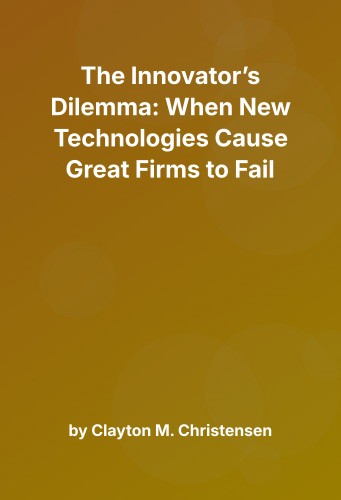Summary
Clayton Christensen’s The Innovator’s Dilemma explores a paradox that challenges traditional business strategy: why do successful, well-managed companies fail when faced with certain types of market and technological changes?
The answer lies in a new kind of innovation—disruptive innovation—that upends existing markets not by being better, but by being different: simpler, cheaper, and accessible to new or underserved customer segments.
Christensen’s work is grounded in empirical studies from industries like disk drives, mechanical excavators, and retailing, and it introduces a strategic framework that leaders can use to navigate and embrace innovation rather than fall victim to it.
Key Concepts
1. Disruptive vs. Sustaining Innovation
- Sustaining innovations improve existing products for established customers.
- Disruptive innovations offer worse performance (initially), but are cheaper, simpler, and meet new needs in emerging markets.
Incumbents excel at sustaining innovation but struggle with disruptive innovation because their processes and values are tuned to existing customers and markets.
2. The Innovator’s Dilemma
Firms are punished for investing in disruptive innovations that don’t serve current customers or generate immediate returns. Paradoxically, doing the “right” thing—listening to customers, maximizing profit, focusing on core competencies—leads to failure when a market is disrupted.
3. Technology Trajectories and Performance Oversupply
Firms often improve products faster than customers can absorb. This leaves room at the bottom of the market for simpler solutions to take hold, improving over time until they displace incumbents.
4. Why Good Companies Fail
- They listen too closely to current customers
- Their financial metrics discourage high-risk, low-margin innovation
- They wait until new markets are large enough to be attractive—by then, it’s too late
- Their organizational structures don’t support small, uncertain bets
5. Market Creation vs. Market Competition
Disruptive innovators create new markets, often by targeting overlooked segments. These markets may seem unattractive or insignificant to incumbents—but they become the beachhead for future dominance.
Case Studies
• Disk Drive Industry
A prime example where smaller, cheaper drives (e.g., 5.25” vs. 8”) started in low-end applications but evolved to dominate the mainstream. Entrants thrived while incumbents perished.
• Retailing (e.g., Walmart)
Walmart began in rural areas ignored by large department stores. Its low-cost model eventually reshaped retail at scale.
• Mechanical Excavators
Hydraulic excavators, initially underpowered, eventually replaced cable-operated systems as they matured—despite early resistance from traditional players.
Strategic Implications
1. Create Independent Business Units
To succeed with disruptive innovation, companies must establish autonomous units with different processes, cost structures, and success metrics.
2. Embrace Small Markets
Disruptive innovations start small. Executives must resist dismissing them due to limited short-term revenue or low profit margins.
3. Lead Customers, Don’t Just Follow
While customer feedback is crucial, it’s not always predictive. Companies must sometimes act without customer validation to create future markets.
4. Resource Allocation Reflects Strategy
Where companies spend money and talent shows what they value. Strategy is determined less by what leaders say and more by how resources are deployed.
Why This Matters for Enterprise Architects
Enterprise architects, transformation leaders, and innovation strategists face constant pressure to modernize while supporting legacy systems. The Innovator’s Dilemma is a critical framework for:
- Recognizing early signs of technological disruption
- Structuring organizations to experiment safely
- Avoiding overcommitment to outdated architectures
- Aligning technical evolution with market trends
Understanding this theory empowers leaders to drive innovation—even when it appears to contradict traditional success logic.
Quotes to Remember
“The very decision-making and resource-allocation processes that are key to the success of established companies are the very processes that reject disruptive technologies.”
“Disruptive technologies bring to a market a very different value proposition than had been available previously.”
Further Reading
- The Innovator’s Solution by Clayton Christensen & Michael Raynor
- Blue Ocean Strategy by Kim & Mauborgne
- Crossing the Chasm by Geoffrey Moore
TL;DR
The Innovator’s Dilemma reveals why great firms fail when faced with disruptive technologies. They don’t lack smart leadership—they lack a framework to support innovation that challenges their existing business models. Christensen’s insights remain essential for anyone guiding organizations through change.

